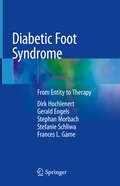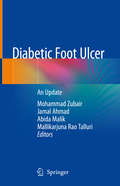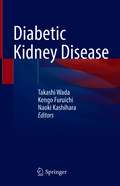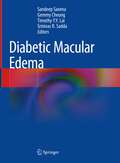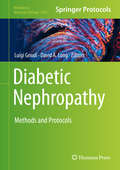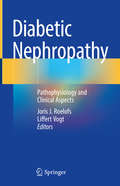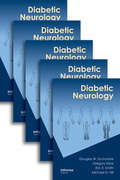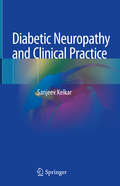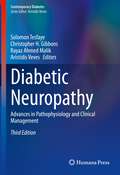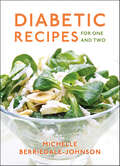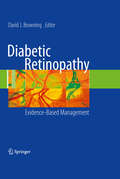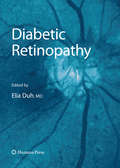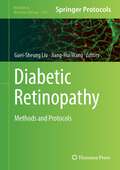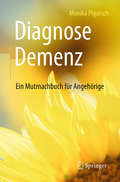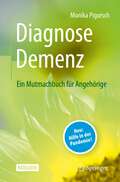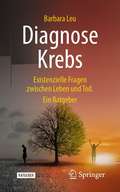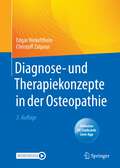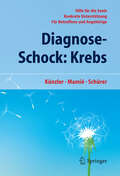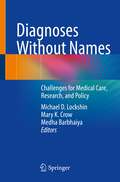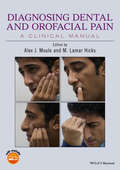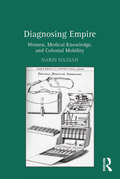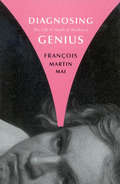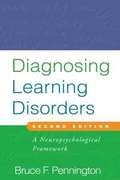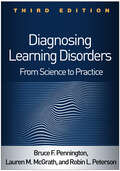- Table View
- List View
Diabetic Foot Syndrome: From Entity to Therapy
by Dirk Hochlenert Gerald Engels Stephan Morbach Stefanie Schliwa Frances L. GameThis book provides a clear and integrated guide to the diagnostic pathways and therapeutic options available for the treatment of diabetic foot syndrome. The link between the location of the lesion and its potential causes are discussed in relation to its diagnosis, biomechanics, treatment and prognosis. Chapters covering interdigital lesions, the lateral side of the foot, torsion of the hallux, and the charcot foot are included. Diabetic Foot Syndrome: From Entity to Therapy aims to facilitate interdisciplinary understanding and is relevant to endocrinologists, as well as vascular and orthopedic surgeons.
Diabetic Foot Ulcer: An Update
by Jamal Ahmad Abida Malik Mohammad Zubair Mallikarjuna Rao TalluriThis book discusses essential aspects of diabetic foot ulcers, including evidence-based information on its pathogenesis and pathophysiology, as well as the molecular mechanisms and biomechanics of the diabetic foot. It also highlights the need for a multidisciplinary team to be involved in the management of diabetic patients with foot ulcers, and describes available and future tools for evaluating patients who are at risk. Exploring the main current therapies as well as the latest developments, future directions and potential new treatments, such as growth factors, stem cell therapy, alternative medicine and nanotechnology, the book is a valuable resource for clinicians and medical graduates but will also appeal to researchers working in the field.
Diabetic Kidney Disease
by Takashi Wada Kengo Furuichi Naoki KashiharaThis book presents the latest information on the clinical-pathological features of diabetic kidney disease. The data included is based on a cohort study of biopsy-proven diabetic nephropathy patients and nephrosclerosis patients, who were observed over a long term, and on the long-term registry for diabetic nephropathy (diabetic kidney disease) in Japan. It provides a clinical-pathological axis in clinical settings, including differential pathological/clinical diagnoses of CKD in diabetic patients (e.g. the presence of “classic” diabetic nephropathy and/or nephrosclerosis and/or other primary kidney diseases). The abundant biopsy specimens with long-term medical records provide a detailed pathological and clinical description. The book also includes urine-sample data for developing and validating possible candidates for novel biomarkers for diabetic kidney disease.Many countries, including Japan, have ageing populations, in which nephrosclerosis contributes to the progression of kidney lesions in patients with diabetic kidney disease. As such, a comparison of a diabetic nephropathy cohort with nephrosclerosis is indispensable to offer better treatments.This comprehensive and informative book is an indispensible reference resource for all physicians and researchers in the field of nephrology and diabetes.
Diabetic Living Quick and Easy Meals
by Diabetic LivingDelicious meals in minutes the whole family will enjoy Eat right for diabetes and get dinner on the table fast with this photo-filled collection of easy, everyday meals from Diabetic Living-the only lifestyle magazine for individuals living with diabetes. These fast-fix recipes-low in fat, carb-smart, and made with nutrient-rich ingredients-make it easy to put healthy meals on the table every night of the week. Enjoy mouthwatering main dishes, such as Pesto Turkey Burgers, Mediterranean Tostadas, and Pork Chops Primavera. You'll find the most current information on the best foods to choose in an eating plan and lots of timesaving tips for making healthy meals in a snap. Includes 120 fresh and tasty recipes with a color photo of every recipe Every recipe for breakfast, sandwiches, soups and stews, entrees, salads, and sides is ready in 30 minutes or less Special slow-cooker and dessert chapters featuring recipes that require only 20 minutes or less of prep time Recipes highlight total grams of carbohydrate per serving and provide full nutrition information Clear serving-size icons make it easy to see the satisfying portion sizes With Diabetic Living Quick & Easy Diabetic Meals, fast, fresh food is never far away!
Diabetic Macular Edema
by Sandeep Saxena Gemmy Cheung Timothy Y. Y. Lai Srinivas R. SaddaThe book focuses on diabetic macular edema and provides comprehensive practical knowledge on the subject. This timely book summarizes all the aspects of diabetic macular edema. The book is edited by leading authorities of vitreoretinal diseases having expertise in diabetic macular edema. It comprises over dozen chapters, authored by a subject authority in the world. Chapters provide diagnostic, medical and surgical approach. The book is clinically relevant, covers application of the latest clinical trials as well as application of novel imaging technologies. It includes uniquely structured chapters for easy learning.The book is beneficial to ophthalmic resident doctors, retina fellows and practicing retina specialists throughout the world.
Diabetic Nephropathy: Methods and Protocols (Methods in Molecular Biology #2067)
by Luigi Gnudi David A. LongThis book provides a toolkit of novel research approaches for investigators to study diabetic nephropathy, including critical experimental models from the fly to the fish, cells in culture, and in vivo mammalian approaches. The collection also explores powerful techniques to image the kidney, such as traditional histological techniques as well as electron, confocal, and two-photon microscopy, pathophysiology of the diabetic kidney, and gene editing and regenerative medicine. Written for the highly successful Methods in Molecular Biology series, chapters include introductions to their respective topics, lists of the necessary materials and reagents, step-by-step, readily reproducible laboratory protocols, and tips on troubleshooting and avoiding known pitfalls. Authoritative and practical, Diabetic Nephropathy: Methods and Protocols seeks to foster new research directions and inspire ideas to enhance our understanding of diabetic nephropathy and to develop treatments for this condition.
Diabetic Nephropathy: Pathophysiology And Clinical Aspects
by Joris J. Roelofs Liffert VogtThis book provides an overview of the most up-to-date research on diabetic nephropathy and the current understanding of its pathogenesis, clinical features and socio-economic developments. Written by leading experts in the field, it provides a comprehensive synthesis of clinical and pathophysiological aspects from a mechanism-based point of view, and reviews evidence-based treatment modalities for the prevention and management of diabetic nephropathy. In addition, closely related areas such as diabesity, diabetic eye disease and macrovascular involvement in diabetes are addressed. Diabetic Nephropathy will be of interest for nephrologists, diabetologists, internists, transplant physicians, public health professionals, basic scientists, geneticists, epidemiologists, pathologists, and molecular and cell biologists working in the field of diabetes and its complications.
Diabetic Neurology
by Douglas W. Zochodne Michael D. Hill Gregory Kline Eric E. SmithDiabetic Neurology offers a unique focus on the broad neurological complications of diabetes, bridging the clinical divide between diabetology and neurology with a practitioner-friendly guide for the recognition, investigation and management of diabetic patients with neurological disease.This book provides a comprehensive, practical review of the p
Diabetic Neuropathy and Clinical Practice
by Sanjeev KelkarDiabetic Neuropathy and Clinical Practice aims to improve the pathophysiological understanding of the entire spectrum from sensory motor to autonomic diabetic neuropathy, its correlation with the symptoms, improving thereby the communication with the patient including prognostication and other tools that one should utilize to better management. It also emphasizes the need to regain the grip on the basic sciences of clinical medicine to deal with it better - Anatomy, Physiology, Biochemistry and Pathology and gives the necessary details. The volume aims at explaining what the clinicians need most to help patients and may not possess.
Diabetic Neuropathy: Advances in Pathophysiology and Clinical Management (Contemporary Diabetes)
by Aristidis Veves Christopher H. Gibbons Solomon Tesfaye Rayaz Ahmed MalikIn this updated edition, leading medical specialists critically review for the general practitioner the latest techniques for the clinical management of diabetic neuropathy. The contributors focus on the practical aspects of diabetic neuropathy and describe in detail the treatments that are currently available or expected to become available in the near future. They also include concise discussions of the pathogenesis of diabetic neuropathy.
Diabetic Recipes for One and Two
by Michelle Berriedale-JohnsonOver 500 million people worldwide are living with diabetes. There is a continued universal increase in prevalence, confirming diabetes as a significant global challenge to the health and well-being of individuals, families and societies. Present figures indicate USA more than 130 million, UK almost 5 million, and 1.3 million in Australia with alarming levels of increase in Pakistan, India and the Middle East. Most cases of diabetes are Type 2 (non-insulin dependent) and happily this is controlled by diet and exercise. However, as many of today’s diabetics are either living alone or as a couple, preparing meals using regular diabetic cookbooks which cater for four or more people can provide meals that are too big and wasteful. Diabetic Recipes for One and Two solves the problem by offering a collection of easy, tempting recipes in smaller portions. Based on the very latest research it gives nutritional guidelines, advice on how to shop and plan your meals and over 100 recipes catering for contemporary culinary tastes, consisting of meals with a high intake of vegetables, pulses, fruit and whole grains.
Diabetic Retinopathy
by David J. BrowningContains information from the Diabetic Retinopathy Clinical Research network not to be found in other published works Evidence-based approach includes material labeled with level of supporting evidence and many clinical examples Includes discussions of area of controversy
Diabetic Retinopathy
by Elia DuhDiabetic retinopathy is the most common microvascular complication of diabetes. It remains a major cause of new-onset visual loss in the United States and other industrialized nations. In Diabetic Retinopathy, Elia Duh and a panel of internationally recognized experts comprehensively assess the current state of knowledge regarding the clinical management of DR as well as its underlying mechanisms. The authors outline the current understanding of diabetic retinopathy from the perspective of clinical practice, while reviewing the multi-factorial pathogenesis and pathophysiology of DR from the standpoint of biomedical research. Also included is a discussion of emerging concepts relating to the management and treatment of DR. Informative and highly-practical, Diabetic Retinopathy provides ophthalmologists, diabetologists, endocrinologists, and internists with a highly readable guide not only to understanding diabetic retinopathy, but also to its optimal clinical management.
Diabetic Retinopathy: Methods and Protocols (Methods in Molecular Biology #2678)
by Guei-Sheung Liu Jiang-Hui WangThis detailed volume provides various cellular and experimental animal models and research methodologies to understand the complex interrelated pathophysiological mechanisms triggered by hyperglycemia that underlie the development of diabetic retinopathy. The book covers methods for understanding the pathogenesis of diabetic retinopathy, detection and screening of biomarkers in diabetic retinopathy, as well as novel technologies for diabetic retinopathy management. Written for the highly successful Methods in Molecular Biology series, chapters include introductions to their respective topics, lists of the necessary materials and reagents, step-by-step and readily reproducible laboratory protocols, and tips on troubleshooting and avoiding known pitfalls. Authoritative and practical, Diabetic Retinopathy: Methods and Protocols serves as an invaluable resource for scientists and clinicians who are interested in the area of ophthalmology research.
Diagnose Demenz: Ein Mutmachbuch für Angehörige
by Monika PigorschDas Buch richtet sich an Angehörige von Menschen mit Demenz und macht Mut für ein entspannteres Miteinander trotz fortschreitender Erkrankung. Es zeigt Lösungsansätze für vermeintlich aussichtslose Situationen im Alltag mit Demenzerkrankten auf. Das Konzept zielt auf eine Einstellungsänderung ab und hat den pflegenden Angehörigen im Fokus: Eine veränderte Sicht der Dinge kann dazu führen, den Demenzerkrankten besser zu verstehen. Daraus können ein entspannterer Umgang folgen und herausfordernde Situationen erträglicher werden, so dass auch die Sorge für sich selbst beim pflegenden Angehörigen nicht zu kurz kommt. Die Autorin stützt sich auf eine Vielzahl an Fallbeispielen und Erfahrungsberichten aus ihrer 10-jährigen Arbeit mit Angehörigengruppen: In 10 anschaulichen und leicht verständlichen Schritten wird der Leser angeleitet, seine Einstellungen und Vorstellungen im Alltag mit dem Demenzkranken zu reflektieren. Dabei stehen die Beziehung und die Kommunikation stets im Mittelpunkt.
Diagnose Demenz: Ein Mutmachbuch für Angehörige
by Monika PigorschDas Buch richtet sich an Angehörige von Menschen mit Demenz und macht Mut für ein entspannteres Miteinander trotz fortschreitender Erkrankung. Es zeigt Lösungsansätze für vermeintlich aussichtslose Situationen im Alltag mit Demenzerkrankten auf. Das Konzept zielt auf eine Einstellungsänderung ab und hat den pflegenden Angehörigen im Fokus: Eine veränderte Sicht der Dinge kann dazu führen, den Demenzerkrankten besser zu verstehen. Daraus können ein entspannterer Umgang folgen und herausfordernde Situationen erträglicher werden, so dass auch die Sorge für sich selbst beim pflegenden Angehörigen nicht zu kurz kommt. Die Neuauflage wurde mit Hilfen durch die COVID-19 Pandemie ergänzt. Die Autorin stützt sich auf eine Vielzahl an Fallbeispielen und Erfahrungsberichten aus ihrer 10-jährigen Arbeit mit Angehörigengruppen: In 10 anschaulichen und leicht verständlichen Schritten wird der Leser angeleitet, seine Einstellungen und Vorstellungen im Alltag mit dem Demenzkranken zu reflektieren. Dabei stehen die Beziehung und die Kommunikation stets im Mittelpunkt.
Diagnose Krebs: Existenzielle Fragen zwischen Leben und Tod. Ein Ratgeber
by Barbara LeuDie Diagnose Krebs ist für die meisten Menschen ein Schlag mitten ins Gesicht. Nichts mehr ist, wie es einmal war: Das Gedankenkarussell beginnt zu drehen, den Betroffenen stellen sich unzählige Fragen – nach dem Leben und nach dem möglichen Tod.Krebs-Ratgeber gibt es viele und sehr unterschiedliche. Dieser Ratgeber soll nicht einer mehr sein. Er hat wohl die Krebserkrankung und ihre Auswirkungen auf Betroffene und ihre Angehörigen im Zentrum, die Perspektive liegt jedoch immer auf den daraus resultierenden existenziellen Thematiken und Fragestellungen:Warum gerade ich?Wie kann ich das große Leid verkraften?Wie geht mein Leben nach der Krebsdiagnose weiter?Wie kann ich mit der Angst vor dem Tod umgehen?Fall ich anderen zur Last?Trage ich am Ende noch selbst Schuld?Was kann ich als Angehörige*r tun?Diese und weitere existenzielle Fragen und Themen nimmt der vorliegende Ratgeber mit konkreten Fallbeispielen und Hintergrundwissen aus der psychoonkologischen Praxis der Autorin auf und gibt darüber hinaus Anregungen für den Umgang mit solch schweren Erkrankungen. Praktische Tipps und zahlreiche Hilfsangebote zu den einzelnen Themen runden diesen Ratgeber ab.
Diagnose- und Therapiekonzepte in der Osteopathie
by Christoff Zalpour Edgar HinkeltheinWie kombiniert man die in der osteopathischen Ausbildung erlernten Untersuchungs- und Behandlungstechniken zu einem Behandlungskonzept, das optimal auf den Patienten zugeschnitten ist? Antworten liefert das Buch mit Anleitungen zur systematischen Diagnose, zur Planung individueller Therapiekonzepte und zum problemorientierten Testen und Üben. Therapeuten in der Ausbildung erarbeiten sich damit Strategien für ein ganzheitliches Vorgehen, für ausgebildete Osteopathen eignet sich der Band als Nachschlagewerk (mit Index der Leitsymptome).
Diagnose-Schock: Krebs
by Alfred Künzler Andrea Fischer Schulthess Jörg Kyburz Stefan Mamié Susanne Fazekas-Stenz Carmen Schürer Sabine LenzDiagnose-Schock: Krebs Diagnose Krebs: Über 500.000 Menschen in Deutschland, Österreich und der Schweiz erhalten jährlich die Diagnose Krebs. Die medizinischen Fragestellungen haben dann Priorität, oft wird aber die psychologische Betreuung der Patienten auch im Verlauf der Behandlung zu wenig berücksichtigt. Studien zeigen zudem, dass die Partner Krebsbetroffener häufig noch stärker belastet sind als die Patienten. Hilfe für die Seele Dieses Buch bietet praktische Unterstützung für beide Seiten: Patienten und ihre Partner, Freunde, Begleiter. Ziele des Buches: - Sorgen und Hilflosigkeit vermindern - Ihre Lebensqualität verbessern - Selbsthilfe und Selbststeuerung anregen - Sie unterstützen, mit der Erkrankung umzugehen und für sich selbst zu sorgen - Sie unterstützen, Ihren eigenen Weg zu finden - Ihnen in schwierigen Situationen Möglichkeiten aufzeigen - Sie unterstützen, wichtige Dinge nicht zu verpassen. Als klinisch tätige Psychoonkologen zeigen die Autoren vielfach erprobte Hilfestellungen auf. Leserinnen und Leser erhalten kurze, gut lesbare Erklärungen und Anleitungen, die die Ressource Menschlichkeit nutzen. Geschrieben ist das Buch für Betroffene und Angehörige sowie für medizinische und psychosoziale Fachleute in Klinik, Praxis und Reha, die mit Krebsbetroffenen arbeiten. Der praktische Ratgeber für Betroffene und Angehörige: In der Krise lesbar und bezogen auf den ganzen Menschen
Diagnoses Without Names: Challenges for Medical Care, Research, and Policy
by Michael D. Lockshin Mary K. Crow Medha BarbhaiyaDoctors, patients, investigators, administrators, and policymakers who assign diagnoses assume three elements: the name describes an entity with conceptual or evidentiary boundaries, the person setting the name has a high degree of certainty, and the name has a consensus definition. This book challenges this practice and offers an alternative to assigning diagnoses: quantitating diagnostic uncertainty in personal and public medical plans.This book offers the stakeholders' views participating in a workshop, sponsored by the Barbara Volcker Center/Hospital for Special Surgery, taking place in April 2020, about uncertain diagnoses. Chapters examine the circumstances in which diagnosis names are "unassignable", either because patients do not fit within diagnostic "boxes" or because health abnormalities evolve and change over time. In addition, the book deconstructs the processes of diagnosis and explores how different stakeholders used diagnosis names for various purposes. In examining pertinent questions, the book offers a roadmap to achieving consensus definitions or including measures of uncertainty in personal care, research, and policy.Diagnoses Without Names: Challenges for Medical Care, Research, and Policy is an essential resource for physicians and related professionals, residents, fellows, and graduate students in internal medicine, rheumatology, and clinical immunology as well as investigators, administrators, policymakers.
Diagnosing Dental and Orofacial Pain: A Clinical Manual
by M. Lamar Hicks Alex J. MouleDiagnosing Dental and Orofacial Pain: A Clinical Manual approaches a complex topic in a uniquely practical way. This text offers valuable advice on ways to observe and communicate effectively with patients in pain, how to analyze a patients' pain descriptions, and how to provide a proper diagnosis of orofacial pain problems that can arise from a myriad of sources--anywhere from teeth, joint and muscle pain, and paranasal sinuses to cluster headaches, neuralgias, neuropathic pain and viral infections. Helps the student and practitioner understand the diagnostic process by addressing the exact questions that need to be asked and then analyzing verbal and non-verbal responses to these Edited by experts with decades of clinical and teaching experience, and with contributions from international specialists Companion website provides additional learning materials including videos, case studies and further practical tips for examination and diagnosis Includes numerous color photographs and illustrations throughout to enhance text clarity
Diagnosing Empire: Women, Medical Knowledge, and Colonial Mobility
by Narin HassanExamining the emerging figure of the woman doctor and her relationship to empire in Victorian culture, Narin Hassan traces both amateur and professional 'doctoring' by British women travelers in colonial India and the Middle East. Hassan sets the scene by offering examples from Victorian novels that reveal the rise of the woman doctor as a fictional trope. Similarly, medical advice manuals by Victorian doctors aimed at families traveling overseas emphasized how women should maintain and manage healthy bodies in colonial locales. For Lucie Duff Gordon, Isabel Burton, Anna Leonowens, among others, doctoring natives secured them access to their private lives and cultural traditions. Medical texts and travel guides produced by practicing women doctors like Mary Scharlieb illustrate the relationship between medical progress and colonialism. They also helped support women's medical education in Britain and the colonies of India and the Middle East. Colonial subjects themselves produced texts in response to colonial and medical reform, and Hassan shows that a number of "New" Indian women, including Krupabai Satthianadhan, participated actively in the public sphere through their involvement in health reform. In her epilogue, Hassan considers the continuing tradition of women's autobiographical narrative inspired by travel and medical knowledge, showing that in the twentieth- and twenty-first century memoirs of South Asian and Middle Eastern women doctors, the problem of the "Woman Question" as shaped by medical discourses endures.
Diagnosing Genius
by François Martin MaiMai's experience as a physician and psychiatrist serves as a basis for his analysis. Working from the symptoms described in the medical evidence, Beethoven's letters and those of his friends, and the reports of his physicians, Mai compares how Beethoven's health complaints would have been understood and treated within the medical, political, and social climate of both his time and ours. He discusses Beethoven's terminal illness and the resulting autopsy report to consider the roles of alcohol, lead poisoning (based on the toxic levels in his hair), and syphilis in causing his death.
Diagnosing Learning Disorders, Second Edition
by Bruce PenningtonFrom a trusted expert in the field, this authoritative work provides an accessible overview of what learning disorders are, how they develop, and how to diagnose and treat them effectively. The author presents the most current neuroscientific knowledge on a range of conditions, including dyslexia, autism spectrum disorders, attention-deficit/hyperactivity disorder, and others. Practitioners gain vital insights and tools for making sense of children's impairments and strengths, collecting and interpreting diagnostic data from a variety of sources, and linking diagnosis to evidence-based interventions. The second edition has been substantially revised and expanded to reflect significant clinical and research advances. New to This Edition Covers additional disorders intellectual disability, mathematics disorder, and developmental coordination disorder, plus a chapter on less well-validated disorders. New case illustrations and a focus on empirically based practice. Now grounded in a multiple cognitive-deficit model of learning disorders, replacing the prior edition's modular, single-deficit model. An illuminating chapter on controversial therapies separates myths from facts.
Diagnosing Learning Disorders, Third Edition: From Science to Practice
by Bruce F. Pennington Lauren M. McGrath Robin L. PetersonA definitive reference--now extensively revised with 70% new material--this book presents cutting-edge knowledge on how learning disorders develop and how to diagnose and treat them effectively. In additional to dyslexia and mathematics disabilities, the book covers speech and language disorders, attention-deficit/hyperactivity disorder, autism spectrum disorder, and intellectual disability. Accessibly written, it is grounded in genetics, neuroscience, and developmental neuropsychology. Clinicians and educators are guided to make sense of children's impairments and strengths and make sound diagnostic decisions. Best practices in intervention are reviewed. User-friendly features include case examples and summary tables in each disorder-specific chapter. New to This Edition *Revised throughout to reflect major theoretical, empirical, and technological advances. *Chapters on etiology, brain development, and comorbidity. *Chapters on DSM-5 diagnosis of specific learning disorder, evidence-based assessment, and achievement gaps.
